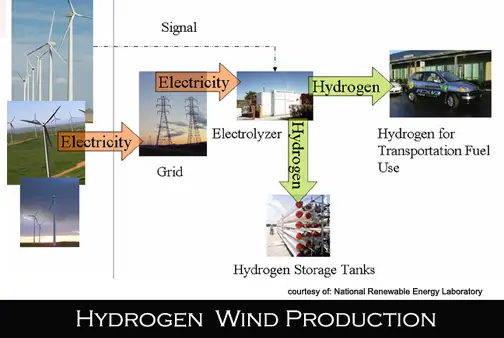 A wind hydrogen wedge can be achieved by eliminating vehicle tailpipe carbon emissions, and through adding 4 million 1 mega watt wind turbines (100 times the current capacity).
A wind hydrogen wedge can be achieved by eliminating vehicle tailpipe carbon emissions, and through adding 4 million 1 mega watt wind turbines (100 times the current capacity).
Firstly, there is the assumption that the substitution of energy as hydrogen for energy as gasoline is one-for-one. Invoking the useful fact that the energy content (lower heating value) of 1 U.S. gallon of gasoline and 1 kg of hydrogen are both almost exactly the same (120 MJ), the one-for-one assumption, therefore, means one ton of hydrogen fuel gets rid of three tons of carbon emissions from vehicle tailpipes.
Assuming the hydrogen vehicle gets 60 miles per gallon of gasoline equivalent and is driven 10,000 miles per year, so it requires 170 kg of hydrogen fuel per year and negates 500 kg of carbon per year in conventional fuels. Two billion cars require 330 million tons of hydrogen per year and cuts out 330 billion gallons of gasoline or diesel fuel, containing 1 giga tonne of carbon per year.
What Is Hydrogen Produced From?
Hydrogen, while the most common element in the universe, isn’t found in its pure form on Earth and must be either electrolysed from water, or stripped out of natural gas, which are energy-intensive processes that result in greenhouse gas emission
However, hydrogen can be produced by using a variety of domestic, renewable sources of energy. Hydrogen-containing compounds such as fossil fuels, biomass or even water can be a source of hydrogen. Power generated from sunlight, wind and nuclear sources can be used to produce hydrogen electrolytically. Sunlight alone can also drive photolytic production of hydrogen from water, using advanced photoelectrochemical and photo biological processes.
How Is Hydrogen Produced?
Electrolysis of water to produce hydrogen and oxygen has been around for at least two hundred years. The technology is well proven and understood, with modern electrolyser units being used by many industries, such as for ammonia manufacture, hydrolysis of edible oils, electronics, metal purification and as a coolant in large electricity generators.
In electrolysis, an electric current is passed through an anode and a cathode in contact with water. This reaction requires 39 kWh of electricity to produce 1 kilogram of hydrogen at 25 degrees C, and 1 atmosphere. The wind hydrogen wedge could contribute to a reduction in greenhouse gases, and when wind levels are high, output from the turbines in excess of the pre-determined supply is used to electrolyse water into hydrogen and oxygen. The hydrogen can then be liquefied or stored under pressure indefinitely.

Hydrogen Vehicles Prototype hydrogen cars have already been developed by BMW, Honda, GM and Ford, and metropolitan buses are also being trialled. The car engines, which are almost silent when the engine is running, can manage around 62 miles per gallon (100 kms per 3.78 litres) of hydrogen and have a range of 190 miles (305 kilometres). It is worth noting that coal, oil, gas, uranium, sunshine, volcanic heat, and tides, are all energy sources, but hydrogen is not. Hydrogen is an energy carrier, and like electricity needs to be made by using a real energy source, such as, a fossil fuel or some alternative energy source.
So a flow diagram of the wind hydrogen wedge looks like this: Wind => electricity => hydrogen => Fuel Cell in car => motor turns wheels
